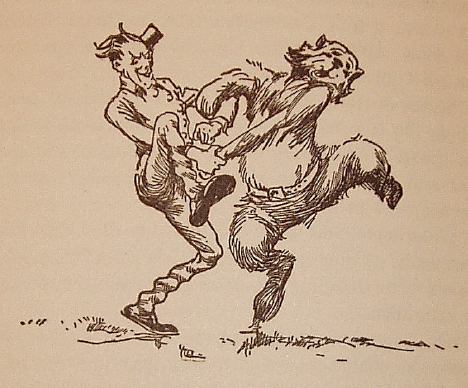Why Does Our Teddy Hunt Bear?
Nov. 4th, 2009 05:36 pmSince Wednesday is my typical day for writing about video games, I considered writing something about games featuring bears, but I don't think I can get an entire post out of that. Banjo-Kazooie, a series of games starring a banjo-playing bear with a bird for a best friend, immediately came to mind, but I've never actually played it nor seen it played. What I've read about it makes it sound pretty cool, but I've never been particularly good at action games. Also worth a mention is Moosh, the winged bear from the Zelda Oracle games. He's portrayed as rather cowardly and not too bright, but how can you not find a flying bear who attacks by butt-slamming his enemies to be cool?


One thing I wonder about is why bears are so prominent in our culture, particularly in works for children. I grew up on the Winnie-the-Pooh stories, and had my own stuffed Pooh, who was actually orange until my mom covered him with beige fur. I also remember reading some of the Paddington books, although I can't remember a whole lot about them other than Paddington lived in London, claimed to originally be from Peru, and was obsessed with orange marmalade. And then there are the Berenstain Bears, whose occasional overtly Christian messages make me wonder if there was a Jesus Bear in their universe. Even the Three Bears are really just innocent victims of breaking and entering. They do eat Goldilocks in earlier versions of the tale, but more recent ones tend to have the girl escaping, presumably having learned her lesson about entering other people's (or bears') houses uninvited. Does this prominence stem from the popularity of teddy bears? The toy, as you probably know, was named after Theodore Roosevelt, due to a 1902 anecdote and subsequent cartoon in which Roosevelt refused to kill a captured bear for sport, but instead ordered a mercy killing. There were toy bears prior to this, but the first actual TEDDY bear, with its cute and upright appearance, was made by Morris Michtom. Well, that's what the story says, anyway; we all know that the truth is rarely that neat. The teddy bear on which the character of Pooh is based was made in England by J.K. Farnell, and I would assume his formal name "Edward Bear" is due to how "Teddy" can be a nickname for Edward as well as for Theodore. Teddy bears have gone through many variations over the years (my own lifetime has seen both Teddy Ruxpin and the Care Bears, and probably other sorts of teddies I'm forgetting), but they remain ubiquitous.

Even the Roosevelt story doesn't totally explain why bears have been deemed good toys and story protagonists for children, but they ARE pretty cute and furry, especially as cubs. They're also associated with hugs, and while a bear hug isn't something you'd want to experience, they perhaps give them impression that bears could give friendly hugs as well as deadly ones, if they really wanted to. Besides, the animals live on four different continents, so they'd be familiar to kids in many different parts of the world.



One thing I wonder about is why bears are so prominent in our culture, particularly in works for children. I grew up on the Winnie-the-Pooh stories, and had my own stuffed Pooh, who was actually orange until my mom covered him with beige fur. I also remember reading some of the Paddington books, although I can't remember a whole lot about them other than Paddington lived in London, claimed to originally be from Peru, and was obsessed with orange marmalade. And then there are the Berenstain Bears, whose occasional overtly Christian messages make me wonder if there was a Jesus Bear in their universe. Even the Three Bears are really just innocent victims of breaking and entering. They do eat Goldilocks in earlier versions of the tale, but more recent ones tend to have the girl escaping, presumably having learned her lesson about entering other people's (or bears') houses uninvited. Does this prominence stem from the popularity of teddy bears? The toy, as you probably know, was named after Theodore Roosevelt, due to a 1902 anecdote and subsequent cartoon in which Roosevelt refused to kill a captured bear for sport, but instead ordered a mercy killing. There were toy bears prior to this, but the first actual TEDDY bear, with its cute and upright appearance, was made by Morris Michtom. Well, that's what the story says, anyway; we all know that the truth is rarely that neat. The teddy bear on which the character of Pooh is based was made in England by J.K. Farnell, and I would assume his formal name "Edward Bear" is due to how "Teddy" can be a nickname for Edward as well as for Theodore. Teddy bears have gone through many variations over the years (my own lifetime has seen both Teddy Ruxpin and the Care Bears, and probably other sorts of teddies I'm forgetting), but they remain ubiquitous.

Even the Roosevelt story doesn't totally explain why bears have been deemed good toys and story protagonists for children, but they ARE pretty cute and furry, especially as cubs. They're also associated with hugs, and while a bear hug isn't something you'd want to experience, they perhaps give them impression that bears could give friendly hugs as well as deadly ones, if they really wanted to. Besides, the animals live on four different continents, so they'd be familiar to kids in many different parts of the world.






